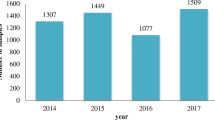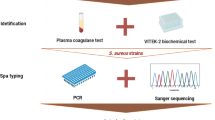Abstract
This study investigated the association between the presence of staphylococcal enterotoxin (SE) genes and nasal carriage status, and determined temporal changes in the prevalence of these genes in Staphylococcus aureus strains isolated from healthy carriers between 2002 and 2011. Three large samples of food handlers recruited in 2002, 2003 and 2011 were nasally sampled on two occasions to determine S. aureus colonisation status. Those carrying the same spa type on both occasions were defined as persistent carriers. Genes for SEs SEA–SEU were amplified and associations between carriage status and presence of SE genes were investigated. Although 80 % of nasal isolates harboured at least one SE gene over the sampling period, persistent carriers were significantly more likely to harbour enterotoxigenic S. aureus than transiently colonised subjects [odds ratio (OR) 2.52–3.06]. Strains from persistent carriers more commonly harboured sea, seb and sem. The prevalence of classical SE genes and sej, sem, sen, seo, seq and ses was stable over time, but seh, sel, sep, ser, set and selu increased significantly. Increased toxigenicity of isolates from persistent carriers is consistent with the elevated antibody levels to classical SEs previously reported in persistent carriers, supporting the hypothesis that superantigen production in the nasal cavity may enhance colonisation.
Similar content being viewed by others

References
Wertheim HFL, Melles DC, Vos MC, van Leeuwen W, van Belkum A, Verbrugh HA, Nouwen JL (2005) The role of nasal carriage in Staphylococcus aureus infections. Lancet Infect Dis 5:751–762
van Belkum A, Verkaik NJ, de Vogel CP, Boelens HA, Verveer J, Nouwen JL, Verbrugh HA, Wertheim HFL (2009) Reclassification of Staphylococcus aureus nasal carriage types. J Infect Dis 199:1820–1826
Colque-Navarro P, Jacobsson G, Andersson R, Flock JI, Möllby R (2010) Levels of antibody against 11 Staphylococcus aureus antigens in a healthy population. Clin Vaccine Immunol 17:1117–1123
Kolata J, Bode LG, Holtfreter S, Steil L, Kusch H, Holtfreter B, Albrecht D, Hecker M, Engelmann S, van Belkum A, Völker U, Bröker BM (2011) Distinctive patterns in the human antibody response to Staphylococcus aureus bacteremia in carriers and non-carriers. Proteomics 11:3914–3927
Burian M, Grumann D, Holtfreter S, Wolz C, Goerke C, Bröker BM (2012) Expression of staphylococcal superantigens during nasal colonization is not sufficient to induce a systemic neutralizing antibody response in humans. Eur J Clin Microbiol Infect Dis 31:251–256
Holtfreter S, Roschack K, Eichler P, Eske K, Holtfreter B, Kohler C, Engelmann S, Hecker M, Greinacher A, Broker BM (2006) Staphylococcus aureus carriers neutralize superantigens by antibodies specific for their colonizing strain: a potential explanation for their improved prognosis in severe sepsis. J Infect Dis 193:1275–1278
Harrison LM, Morris JA, Bishop LA, Lauder RM, Taylor CA, Telford DR (2004) Detection of specific antibodies in cord blood, infant and maternal saliva and breast milk to staphylococcal toxins implicated in sudden infant death syndrome (SIDS). FEMS Immunol Med Microbiol 42:94–104
Holtfreter S, Nguyen TT, Wertheim H, Steil L, Kusch H, Truong QP, Engelmann S, Hecker M, Völker U, van Belkum A, Bröker BM (2009) Human immune proteome in experimental colonization with Staphylococcus aureus. Clin Vaccine Immunol 16:1607–1614
van Belkum A, Melles DC, Nouwen J, Van Leeuwen WB, Van Wamel W, Vos MC, Wertheim HF, Verbrugh HA (2009) Co-evolutionary aspects of human colonisation and infection by Staphylococcus aureus. Infect Genet Evol 9:32–47
Jarraud S, Peyrat MA, Lim A, Tristan A, Bes M, Mougel C, Etienne J, Vandenesch F, Bonneville M, Lina G (2001) egc, a highly prevalent operon of enterotoxin gene, forms a putative nursery of superantigens in Staphylococcus aureus. J Immunol 166:669–677
Holtfreter S, Kolata J, Bröker BM (2010) Towards the immune proteome of Staphylococcus aureus - The anti-S. aureus antibody response. Int J Med Microbiol 300:176–192
Omoe K, Hu DL, Ono HK, Shimizu S, Takahashi-Omoe H, Nakane A, Uchiyama T, Shinagawa K, Imanishi K (2013) Emetic potentials of newly identified staphylococcal enterotoxin-like toxins. Infect Immun 81:3627–3631
Wattinger L, Stephan R, Layer F, Johler S (2012) Comparison of Staphylococcus aureus isolates associated with food intoxication with isolates from human nasal carriers and human infections. Eur J Clin Microbiol Infect Dis 31:455–464
Argudín MA, Argumosa V, Mendoza MC, Guerra B, Rodicio MR (2013) Population structure and exotoxin gene content of methicillin-susceptible Staphylococcus aureus from Spanish healthy carriers. Microb Pathog 54:26–33
Chiang YC, Liao WW, Fan CM, Pai WY, Chiou CS, Tsen HY (2008) PCR detection of staphylococcal enterotoxins (SEs) N, O, P, Q, R, U, and survey of SE types in Staphylococcus aureus isolates from food-poisoning cases in Taiwan. Int J Food Microbiol 121:66–73
Ho J, Boost MV, O’Donoghue MM (2014) Sustainable reduction of nasal colonization and hand contamination with Staphylococcus aureus in food handlers, 2002–2011. Epidemiol Infect 143:1751–1760
Mehrotra M, Wang G, Johnson WM (2000) Multiplex PCR for detection of genes for Staphylococcus aureus enterotoxins, exfoliative toxins, toxic shock syndrome toxin 1, and methicillin resistance. J Clin Microbiol 38:1032–1035
Monday SR, Bohach GA (1999) Use of multiplex PCR to detect classical and newly described pyrogenic toxin genes in staphylococcal isolates. J Clin Microbiol 37:3411–3414
Ono HK, Omoe K, Imanishi K, Iwakabe Y, Hu DL, Kato H, Saito N, Nakane A, Uchiyama T, Shinagawa K (2008) Identification and characterization of two novel staphylococcal enterotoxins, types S and T. Infect Immun 76:4999–5005
Harmsen D, Claus H, Witte W, Rothgänger J, Claus H, Turnwald D, Vogel U (2003) Typing of methicillin-resistant Staphylococcus aureus in a university hospital setting by using novel software for spa repeat determination and database management. J Clin Microbiol 41:5442–5448
van Belkum A, Tassios PT, Dijkshoorn L, Haeggman S, Cookson B, Fry NK, Fussing V, Green J, Feil E, Gerner-Smidt P, Brisse S, Struelens M; European Society of Clinical Microbiology and Infectious Diseases (ESCMID) Study Group on Epidemiological Markers (ESGEM) (2007) Guidelines for the validation and application of typing methods for use in bacterial epidemiology. Clin Microbiol Infect 13(Suppl 3):1–46
Udo EE, Al-Mufti S, Albert MJ (2009) The prevalence of antimicrobial resistance and carriage of virulence genes in Staphylococcus aureus isolated from food handlers in Kuwait city restaurants. BMC Res Notes 2:108
Monecke S, Luedicke C, Slickers P, Ehricht R (2009) Molecular epidemiology of Staphylococcus aureus in asymptomatic carriers. Eur J Clin Microbiol Infect Dis 28:1159–1165
Holtfreter S, Bauer K, Thomas D, Feig C, Lorenz V, Roschack K, Friebe E, Selleng K, Lövenich S, Greve T, Greinacher A, Panzig B, Engelmann S, Lina G, Bröker BM (2004) egc-Encoded superantigens from Staphylococcus aureus are neutralized by human sera much less efficiently than are classical staphylococcal enterotoxins or toxic shock syndrome toxin. Infect Immun 72:4061–4071
Derzelle S, Dilasser F, Duquenne M, Deperrois V (2009) Differential temporal expression of the staphylococcal enterotoxins genes during cell growth. Food Microbiol 26:896–904
Machuca MA, Sosa LM, González CI (2013) Molecular typing and virulence characteristic of methicillin-resistant Staphylococcus aureus isolates from pediatric patients in Bucaramanga, Colombia. PLoS One 8(8):e73434
Climo MW, Sepkowitz KA, Zuccotti G, Fraser VJ, Warren DK, Perl TM, Speck K, Jernigan JA, Robles JR, Wong ES (2009) The effect of daily bathing with chlorhexidine on the acquisition of methicillin-resistant Staphylococcus aureus, vancomycin-resistant Enterococcus, and healthcare-associated bloodstream infections: results of a quasi-experimental multicenter trial. Crit Care Med 37:1858–1865
David MZ, Siegel JD, Henderson J, Leos G, Lo K, Iwuora J, Porsa E, Schumm LP, Boyle-Vavra S, Daum RS (2014) A randomized, controlled trial of chlorhexidine-soaked cloths to reduce methicillin-resistant and methicillin-susceptible Staphylococcus aureus carriage prevalence in an urban jail. Infect Control Hosp Epidemiol 35:1466–1473
Acknowledgments
This study was funded by a research grant from the School of Nursing, The Hong Kong Polytechnic University, Hong Kong. Part of this study was presented as a poster at the 6th International Infection Control Conference Hong Kong August 2014. The authors are grateful to Dr. Katsuhiko Omoe, Iwate University, Japan for the donation of reference strains for the detection of staphylococcal enterotoxin (SE) genes.
Conflict of interest
The authors declare that there are no conflicts of interest.
Author information
Authors and Affiliations
Corresponding author
Rights and permissions
About this article
Cite this article
Ho, J., Boost, M. & O’Donoghue, M. Prevalence of enterotoxin genes in Staphylococcus aureus colonising food handlers: does nasal carriage status matter?. Eur J Clin Microbiol Infect Dis 34, 2177–2181 (2015). https://doi.org/10.1007/s10096-015-2465-z
Received:
Accepted:
Published:
Issue Date:
DOI: https://doi.org/10.1007/s10096-015-2465-z



